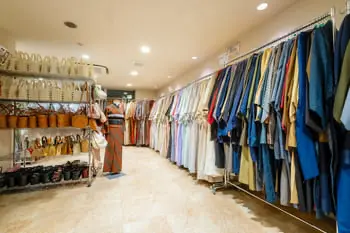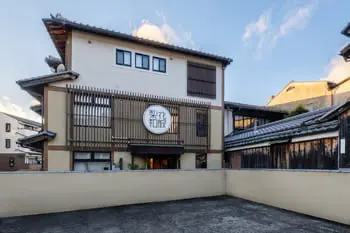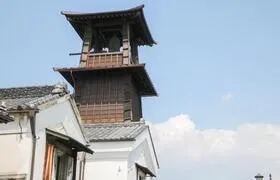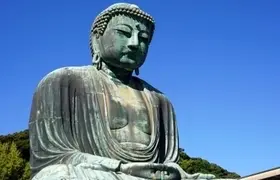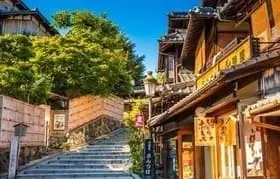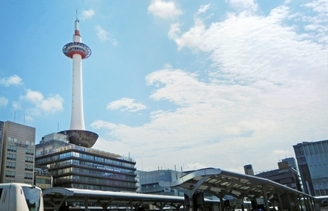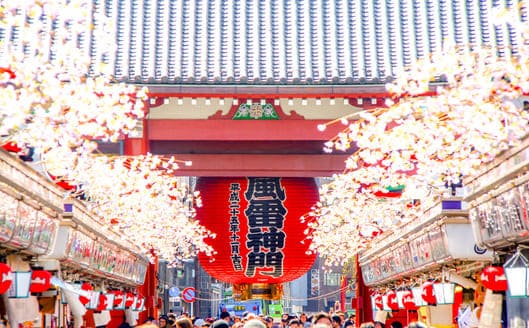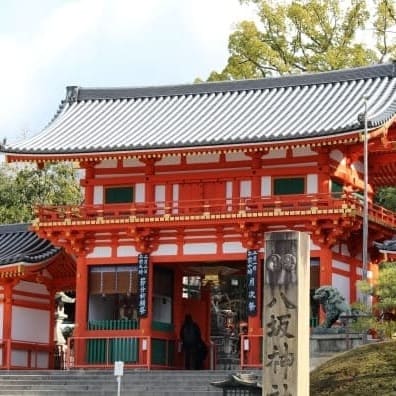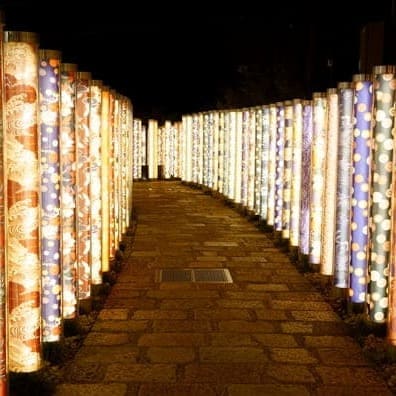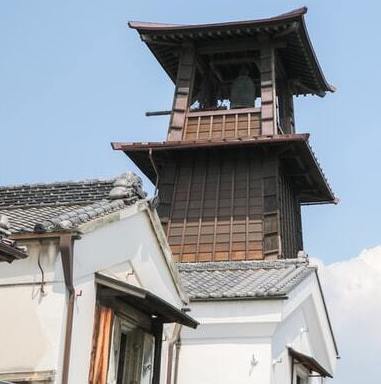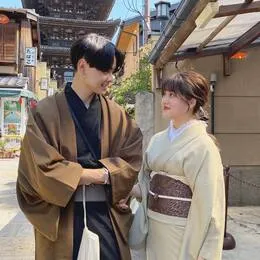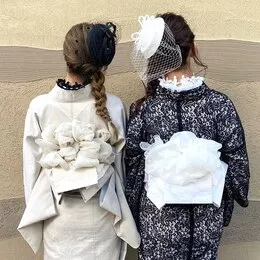【Basic Knowledge】What Are the Differences Between Hōmongi and Iro-tomesode?

Visiting kimono (homongi) and colored long-sleeved kimono (iro tomesode) are outfits that anyone interested in kimono would want to try on at least once.
Both of these kimonos are essential for celebratory occasions and are likely to be seen frequently.
However, because both visiting kimono and colored long-sleeved kimono have a wide range of wear, it can be confusing to determine when and where to wear each of them.
This may be considered a somewhat troublesome feature of these two kimonos.
So, in this article, we will provide clear explanations of the differences between visiting kimono and colored long-sleeved kimono and how to wear them for different occasions.
Reference:
Differences between Furisode and Houmongi(visiting kimono)
- 1. Visiting Kimono: Kimono for Outings
- 2. Colored Long-Sleeved Kimono: A Fashionable Formal Attire
- 2.1. Variation in the Formality of Colored Long-Sleeved Kimono Based on Crests
- 2.2. 1. Five Crests: First-Class Attire for Weddings
- 2.3. 2. Three Crests: Semi-Formal Attire for Wedding Receptions and Parties
- 2.4. Styling Colored Long-Sleeved Kimono as First-Class Attire
- 2.5. Styling Colored Long-Sleeved Kimono as Semi-Formal Attire
- 3. Conclusion
Differences Between Visiting Kimono and Colored Long-Sleeved Kimono and How to
Distinguish Them
- Visiting kimono can be worn with or without crests, while colored long-sleeved kimono always have crests.
- To distinguish them: Visiting kimono have patterns throughout the entire garment, while colored long-sleeved kimono have patterns only on the lower part under the obi and on the hem.
Visiting kimono (homongi) and colored long-sleeved kimono (iro tomesode) are both formal kimono worn on celebratory occasions.
While visiting kimono can be worn with or without crests, colored long-sleeved kimono always require crests according to traditional customs.
In other words, visiting kimono (homongi) is a semi-formal (semi-ceremonial) kimono among formal wear, while colored long-sleeved kimono (iro tomesode) can range from formal (full ceremonial) to semi-formal (semi-ceremonial) depending on the number of crests.
To distinguish between these two kimonos, let’s focus on the patterns.
Visiting kimono have patterns throughout the entire garment, while colored long-sleeved kimono have patterns only on the lower part under the obi and on the hem.
Therefore, the key difference is that visiting kimono have patterns all over the kimono, while colored long-sleeved kimono have patterns only at the hem.
Visiting Kimono: Kimono for Outings
- Can be worn by people of all ages
- Considered a formal attire, following black long-sleeved kimono and colored long-sleeved kimono
Visiting kimono is a kimono that can be worn casually, unlike formal attire, making it suitable for outings.
Furthermore, people of various ages, whether married or unmarried, can wear it elegantly.
Visiting kimono has patterns throughout the entire garment, and when spread out, it looks like a single painting.
These patterns are known as “eba” patterns and are a distinctive feature of visiting kimono.
It is considered a formal attire, following black long-sleeved kimono and colored long-sleeved kimono, and is worn as semi-formal attire.
While it can have one crest, it has become common in recent years to wear it without any crests.
Wide Range of Wear for Visiting Kimono
Visiting kimono patterns vary from auspicious classical patterns to modern abstract patterns, which has expanded its range of wear.
There are plenty of occasions to wear visiting kimono, including attending weddings and wedding receptions, matchmaking meetings, engagement ceremonies, Shichi-Go-San (a traditional rite of passage for children), accompanying children at school entrance and graduation ceremonies, attending theatrical performances, parties, greetings after marriage, and the first shrine visit of the year.
Wearing Visiting Kimono as Semi-Formal Attire
- Occasions: Attending wedding receptions, greetings after marriage, accompanying children at Shichi-Go-San or school entrance/graduation ceremonies
If you are attending formal events, wearing visiting kimono as semi-formal attire is appropriate.
It is suitable for occasions such as attending wedding receptions, greetings after marriage, accompanying children at Shichi-Go-San (a traditional rite of passage for children), or school entrance and graduation ceremonies.
When wearing a visiting kimono, it’s appropriate to choose auspicious traditional patterns, and for the obi (sash), select a formal Fukuro obi.
Please prepare a white collar, and choose obiage (obi scarf) and obijime (obi cord) in light colors.
While a white nagajuban (undergarment) is acceptable, one with a subtle, blurred pattern can also look charming.
Pair it with enamel zori sandals that complement the kimono’s base color.
Styling Visiting Kimono as Fashionable Attire
You can also style a visiting kimono as fashionable attire.
Create opportunities to wear it by attending theater performances, parties, alumni gatherings, and New Year’s visits to shrines, among other outings.
Choose kimono patterns that match your preference, ranging from traditional patterns to floral motifs and modern abstract designs.
For the obi, consider both formal Fukuro obi and playful fashionable obi styles.
Pairing a white collar with an embroidered one can also look delightful.
A pale tie-dye nagajuban adds a touch of style.
Ensure that the enamel zori sandals match the kimono’s base color.
Colored Long-Sleeved Kimono: A Fashionable Formal Attire
- While black long-sleeved kimono is for married women only, colored long-sleeved kimono can be worn by both married and unmarried individuals
Colored long-sleeved kimono is originally a first-class formal attire, similar to black long-sleeved kimono, adorned with five crests.
There are no patterns above the obi, only crests, and the ebira patterns are only present at the hem.
While black long-sleeved kimono is exclusively for married women, colored long-sleeved kimono can be worn by both married and unmarried individuals as fashionable formal attire.
They can be dyed in any color other than black, and there is a wide variety of hem patterns available, from traditional to modern designs.
In recent years, reducing the number of crests and wearing them as semi-formal attire has become a trend.
Variation in the Formality of Colored Long-Sleeved Kimono Based on Crests
The formality of colored long-sleeved kimono varies based on the number of crests, affecting the occasions for wearing them.
- 1. Five crests: First-class attire suitable for weddings
- 2. Three crests: Semi-formal attire suitable for wedding receptions and parties
- 3. One crest: Semi-formal attire suitable for banquets and accompanying children’s events
1. Five Crests: First-Class Attire for Weddings
Colored long-sleeved kimono with five crests is a first-class formal attire, equivalent to black long-sleeved kimono, and is worn with a white uchikake (outer kimono).
It can be worn by sisters of the bride and groom who have graduated from furisode, as well as aunts and other relatives.
It’s worth noting that mothers and grandmothers of the bride and groom typically wear black long-sleeved kimono. Additionally, wearing colored long-sleeved kimono is customary at imperial ceremonies, so be mindful of your attire if you receive an invitation to such an event.
2. Three Crests: Semi-Formal Attire for Wedding Receptions and Parties
Colored long-sleeved kimono with three crests is considered semi-formal attire, but if it has an uchikake, it can be seen as equivalent to five-crest kimono, allowing you to attend relatives’ weddings.
It is also suitable attire when invited as the guest of honor to wedding receptions.
If an uchikake is not attached, you can wear it similarly to visiting kimono.
Why not elegantly wear it for parties, theater outings, and other events?
3. One Crest: Semi-Formal Attire for Banquets and Accompanying Children’s
Events
Colored long-sleeved kimono with one crest is the least formal option for colored long-sleeved kimono, worn without an uchikake.
It is equivalent to semi-formal attire, similar to visiting kimono.
In addition to attending wedding banquets, it can be worn for parties, theater outings, and other fashionable occasions.
It’s also a lovely choice for mothers attending Shichi-Go-San or children’s school entrance and graduation ceremonies.
Styling Colored Long-Sleeved Kimono as First-Class Attire
If you choose to wear colored long-sleeved kimono as first-class attire, tie it with a formal Fukuro obi.
Use white obiage and obijime, and opt for a white collar and a white or pale-colored nagajuban.
Match your zori sandals and bag to the kimono’s base color, and accessorize with items such as a fan and hair ornaments, following the same style as black long-sleeved kimono.
Styling Colored Long-Sleeved Kimono as Semi-Formal Attire
You can also style colored long-sleeved kimono as semi-formal attire.
In this case, you can follow a similar approach to how you would style visiting kimono.
Choose an obi that matches the kimono’s color and pattern from formal Fukuro obi, and select obiage and obijime in light shades.
Enamel zori sandals in a color that complements the kimono will also work well.
Conclusion
Visiting kimono, with its picturesque ebira patterns throughout the entire garment, is a versatile kimono suitable for various occasions and outings.
On the other hand, colored long-sleeved kimono, whether worn with or without crests, is a fashionable formal attire adorned with hem patterns.
The number of crests determines its formality and appropriate occasions.
Both visiting kimono and colored long-sleeved kimono are appropriate garments for expressing joy and celebrating special occasions.
You can make a reservation for a visiting kimono here:
>Furisode and Visiting Kimono Hair Set Plan
Check the Rikawafuku Rental!

